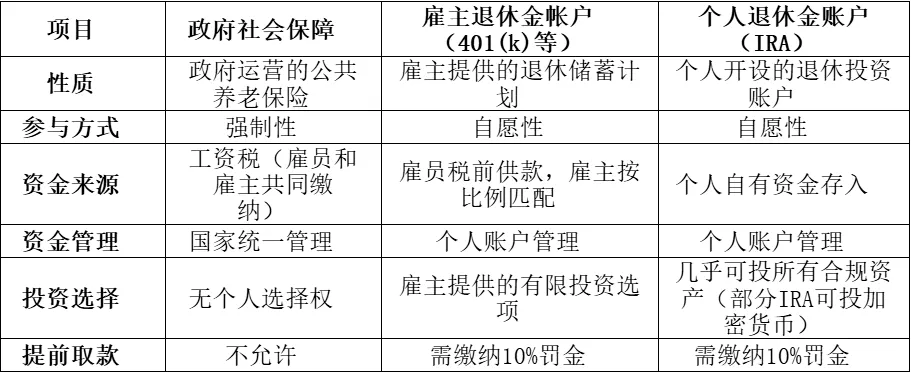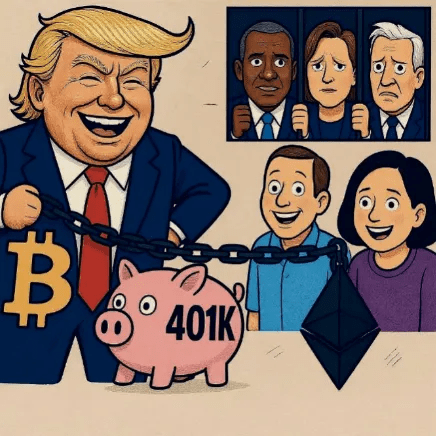Author | FinTax Owen
On August 7, U.S. Eastern Time, President Trump signed an executive order at the White House titled 'Democratizing Access to Alternative Assets for 401(k) Investors.' It requires the Treasury Department, Labor Department, and Securities and Exchange Commission (SEC) to initiate rule amendments to include 'Alternative Assets' such as cryptocurrencies, real estate, and private equity in 401(k) pension investments. This news hit like a bolt from the blue, quickly shaking the global financial markets — it not only has the potential to unlock a retirement pool of up to $8.7 trillion but is also seen as a key step for crypto assets moving from the fringes to the mainstream financial system.
Although the White House claims that this move aims to 'expand ordinary investors' access to diversified assets,' a core question emerges: does this open a new chapter for wealth appreciation for the retirement future of Americans, or is it a reckless national gamble?
1. 401(k) Plans: The Cornerstone of the U.S. Pension System
To understand the significance of this move, one must first grasp the weight of 401(k) in the U.S. retirement security system. The U.S. pension system consists of three main pillars: the first pillar is the government-operated mandatory Social Security, which pays a basic pension to retirees monthly; the second pillar is employer-sponsored retirement savings plans, where 401(k) is the most popular, accumulating funds through employee pre-tax contributions and employer matching contributions, along with limited investment options provided by employers; the third pillar is Individual Retirement Accounts (IRAs), which are voluntarily opened by individuals and have a broader range of investment options, with some types of IRAs already allowing investments in cryptocurrencies.

In the second pillar, 401(k) is the most representative employer pension plan, with most employers supporting employee participation and accumulating funds through payroll deductions and matching contributions to achieve compound growth. Besides 401(k), there are also 403(b) plans for employees of public educational institutions and certain non-profit organizations. As of the first quarter of 2025, the U.S. 401(k) market size has exceeded $8.7 trillion, serving as the core security for the retirement lives of tens of millions of American families.
Compared to mandatory government social security, the biggest difference between IRAs and 401(k)s as voluntary savings plans lies in investment autonomy: both types of accounts enjoy tax-deferred or tax-free treatment on investment gains, but IRAs have a broader investment scope and can directly hold various assets (including cryptocurrencies in certain types); the investment scope of 401(k)s has been long restricted, with most funds directed towards low-risk products packaged by employer-selected asset management firms (such as mutual funds, bonds, etc.), rather than directly holding spot assets. Trump's reform is precisely about lifting the investment restrictions on 401(k)s, creating institutional conditions for high-volatility assets like cryptocurrencies to enter mainstream retirement investment portfolios.
2. From Prohibition to Allowance: A Shift in Regulatory Concepts and Market Realities
For a long time, U.S. 401(k) plans strictly excluded high-risk assets such as cryptocurrencies, fundamentally due to the need to protect the safety and stability of retirement savings. High volatility is inherently at odds with the goal of stable appreciation of pensions, and regulators are concerned that ordinary investors lack the capacity to bear risks and make professional judgments; once the market experiences severe fluctuations, it will directly impact their retirement security. Additionally, financial institutions face extra costs and risks in custody, valuation, and compliance, which has also prompted the policy to maintain a tightening stance for a long time.
The Trump administration's signing of the executive order to relax restrictions is not a spur-of-the-moment policy but a result of multiple overlapping motivations: on one hand, it responds to the public's demand for high-yield channels in an environment of low interest rates and high inflation, fulfilling the campaign promise of 'deregulation'; on the other hand, it is a realization of political capital — the crypto industry supported Trump’s campaign, and his family also has investments in the crypto space; deeper background is that the crypto market is no longer a fringe experiment but is gradually being viewed as a mainstream asset under the push of institutional investments, ETF approvals, and the acceleration of global compliance processes.
It is worth noting that this policy is not only aimed at cryptocurrencies but at a broader range of 'Alternative Assets,' whose official definition includes private equity, real estate, commodities, and digital currencies. This means the policy's original intent is to comprehensively relax investment restrictions to expand the options available to individual investors, catering to society's enthusiasm for chasing high-yield assets.
It can be said that this shift from 'prohibition' to 'allowance' reflects both the loosening of U.S. regulatory concepts and the changing landscape of capital markets and the re-shaping of the political ecology.
3. Far-reaching Implications: A Gamble May Begin
Including cryptocurrencies and other Alternative Assets in the 401(k) investment scope means that the U.S. government is embarking on an unprecedented high-risk experiment in retirement systems. Once pension funds enter the crypto market on a large scale, it will not only significantly enhance market liquidity and price stability but also create a binding of interests between the government and the crypto market: when the retirement savings of millions of Americans are linked to crypto assets, the government will have to consider how to maintain market stability in policy-making. This deep binding could greatly accelerate the compliance process for cryptocurrencies, compelling regulatory agencies to introduce clearer and more comprehensive regulations, thereby enhancing the maturity, transparency, and credibility of the entire market and attracting more mainstream institutions and individual investors to participate.
At the same time, a deeper political consideration is that the binding of interests may even grant crypto-friendly policies continuity across party transitions. It elevates the protection of cryptocurrencies from a personal or partisan action of Trump to a 'forced choice' by the government to protect the property of its citizens — any measures that weaken the crypto market may be viewed by voters as 'messing with the retirement funds,' potentially triggering a political backlash.

(When your pension is on-chain, do they still dare to say 'no'? Image Source: Author's own)
However, this gamble is fraught with concerns. The crypto market is known for its extreme price volatility, and its cyclical bull-bear transitions often accompany significant asset shrinkage. More critically, structural issues such as fraud, money laundering, and illegal financing still lurk in the market, with some assets lacking transparency and security incidents occurring frequently on trading platforms. If pension funds suffer a severe setback in such an environment, losses will not only be reflected on the books but will also trigger a trust crisis at the societal level — the future security of millions of American families will be directly shaken, and political pressure will quickly transmit to the White House and Congress. At that point, the government may be forced to intervene fiscally to save the market, creating a dual hostage situation between policy and market.
In other words, this move could either propel cryptocurrencies into an era of institutionalization and comprehensive regulation or, in the event of uncontrolled risks, backfire on policymakers, turning this 'bold attempt' into a period of reflection and even criticism.
4. Another Perspective: The Fiscal Game Behind Tax Deferral
For a long time, U.S. 401(k) plans have had two models for tax arrangements: the traditional model adopts 'pre-tax contributions, taxed as ordinary income upon withdrawal in retirement,' while the Roth model is 'post-tax contributions, tax-free withdrawals upon meeting conditions' — regardless of the model, both provide the effect of tax deferral on investment gains, which is also its long-term appeal. Therefore, including crypto assets in the 401(k) investment scope does not change these basic tax law rules, but it means that this high-volatility asset has entered the compliant 'shell' of tax-deferred or tax-free accounts for the first time, allowing investors to bet on the long-term growth of the crypto market while enjoying tax advantages.
Within this framework, the fiscal impact resembles a temporal tax game. For investors choosing 'traditional accounts,' current taxable income decreases, leading to a short-term reduction in government revenue, but in the future, during the withdrawal phase, it will be counted as taxable income all at once, which is a typical 'water the fish' strategy — exchanging today’s gains for a larger tax base decades later. If crypto assets succeed long-term, the gains realized upon retirement could far exceed current levels, thus bringing higher tax revenue for the government; conversely, if the market falters or the policy environment shifts, short-term tax sacrifices may lead to long-term fiscal gaps. This is also the greatest risk and suspense of this move in terms of finance and taxation.



